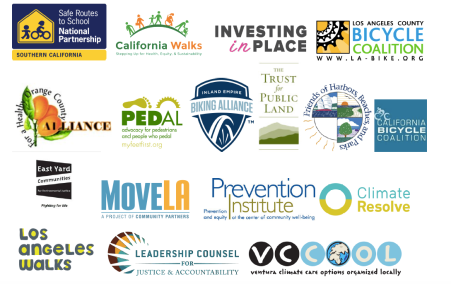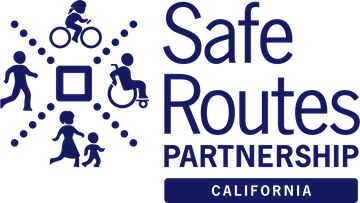The Southern California Association of Governments(SCAG) officially released the draft 2016 Regional Transportation Plan and Sustainable Communities Strategy (RTP/SCS) for public comment in early December, and comments were due on Monday, February 1. The Safe Routes Partnership’s Southern California team have been actively participating in the RTP/SCS update process over the past few years, and we are excited to see an increased emphasis on active transportation, public health, social equity and environmental justice in this plan update. But more can be done to advance policies and increase investments in
these areas. Thus, we submitted a comment letter to SCAG in partnership with 16 organizations: Alliance for a Healthy Orange County, California Bicycle Coalition, California Walks, Climate Resolve, East Yard Communities for Environmental Justice, Friends of Harbors, Beaches & Parks, Inland Empire Biking Alliance, Investing in Place, Leadership Counsel for Justice and Accountability, Los Angeles County Bicycle Coalition, Los Angeles Walks, Move LA, PEDal, Prevention Institute, Trust for Public Land and VC Cool.
 Next Steps: SCAG will be reviewing comments over the next month and provide a summary to the Regional Council at their March3 meeting. The Joint Policy Committees will consider adopting the changes at their March 24 meeting, and the Regional Council will approve the final RTP/SCS at its April 7 meeting.
Next Steps: SCAG will be reviewing comments over the next month and provide a summary to the Regional Council at their March3 meeting. The Joint Policy Committees will consider adopting the changes at their March 24 meeting, and the Regional Council will approve the final RTP/SCS at its April 7 meeting.
A summary of our comments and recommendations is below. Click here to see the full comment letter.
We would like to thank the Southern California Association of Governments (SCAG) staff, Regional Council and Policy Committee members for the opportunity to participate in the 2016 Regional Transportation Plan (RTP) and Sustainable Communities Strategy (SCS) update process. We recognize the multitude of efforts required to develop this long-range plan and appreciate all of the hard work that has already been done.
Elements in the RTP/SCS that we particularly applaud include:
- A doubling of the amount of investment in active transportation, from $6.7 billion to $12.9 billion and shifting these funds forward in time.
- Significant investments in new transit service, especially in LA County, including funding for operations and maintenance to keep the system we already have in good condition.
- Adding a Public Health Appendix to the RTP/SCS for the first time.
- Stronger attention to social equity and environmental justice, especially the more robust data analysis in the Environmental Justice Appendix.
- The growth scenario reduces vehicle miles traveled by 10 percent over the next 25 years, a significant decrease for the region.
We have some concerns, however, with the following:
- Outside of LA County the RTP/SCS is still primarily about funding highways.
- Active transportation, while up from last time, still makes up less than 2% of the RTP/SCS funding amount, yet almost 20% of trips in the region are by walking and bicycling.
- The investment in active transportation is low compared to the need.
- The active transportation strategies’ goal that half of all jurisdictions in the SCAG region would have a Safe Routes to School plan by 2040 is too low.
- SCAG does not adequately link RTP/SCS transit and active transportation funding to its environmental justice obligations.
- Accessibility and proximity to many destinations such as schools, jobs and parks does not improve for many disadvantaged communities in the region, according to the EJ analysis.
- There is no sense of scale in the EJ Appendix.
- The environmental justice analysis, while more robust than the 2012 RTP/SCS, identifies gentrification and displacement as major impacts of making the transportation investments and land use changes identified in the RTP/SCS.
- The RTP/SCS relies on anticipated revenues from sales taxes, which have a record of success in the region, but also on mileage-based user fees and other future sources of revenue that have no track record and may not come to fruition during this timeframe, or that have equity implications for low-income households if they are implemented.
- The selection of the preferred scenario simply meets but does not exceed the targets for 2020 as it did in the 2012 RTP/SCS.
- There is no local accountability to implementing the RTP/SCS.
- The RTP/SCS’ Goods Movement Appendix underscores the need to complement SCAG’s focus on funding the expansion and maintenance of highways with a concomitant commitment to clean vehicles.
- The RTP/SCS promotes the idea that supporting vibrant, well-planned, urban developments means natural lands are protected simultaneously is inaccurate.
Based on the above, we offer the following recommendations to strengthen the 2016 RTP/SCS:
- Invest greater amounts in active transportation.
- It is critical to find a way to expand public transportation in all of the counties in the SCAG region and not just LA County
- Include a target goal for complete streets components of highway projects. The
- Include a target goal for integrating active transportation into transit projects through a first/last mile strategy.
- Commit to completing active transportation planning efforts before the 2020 RTP/SCS.
- Bolster the Safe Routes to School Goal to 75%.
- Identify policies, strategies and investments to increase access to transit and active transportation in less urban areas.
- Disaggregate transportation mode choice at smaller geographies.
- Commit to creating a Regional Gentrification and Displacement Strategy.
- Create a standing Environmental Justice/Disadvantaged Communities Working Group.
- Target Sustainability Planning Grants to Disadvantaged Communities.
- Include target industry goals and include non-industry stakeholders into the Goods Movement Environmental Strategy and Action Plan.
- Track implementation of the RTP/SCS between update cycles.
Overall, the draft RTP/SCS envisions a region where people have more transportation choices: they can walk, bike, take transit, and of course, drive. It has been said by SCAG’s Executive Director that people aren’t going to stop driving, but they will drive differently. By investing more in active transportation and transit, as well as embracing new shared use systems and technologies, we can give everyone in this region a variety of options to get around safely, efficiently and sustainably.
The full comment letter is available here.



